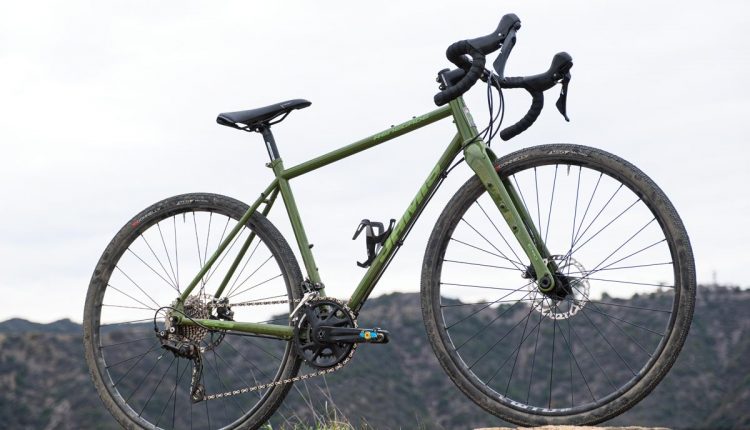Jamis’ Renegade gravel bike line launched eight years ago as a single carbon model. Today, the original bike has evolved into a six-model family of bikes made up of carbon, steel and aluminum frames, each with unique geometries. The Renegade steel family consists of three builds, with the S3 sitting in the middle of the line. Our test bike, the Renegade S3 is built with enough utility to act as a well-balanced entry into the world of bike-packing.
THE FRAME
Reynolds’ 520 double-butted tubes make up most of the front triangle. The higher-end S4 model uses Reynolds’ 631 and has a sportier geometry. Jamis’ Adventure Eco monocoque carbon fork is dotted with three mounts on each leg and helps bring extra vibration damping to the front end. There are also three additional bottle mounts with a set of top tube mounts as well. The mounts up the overall utility of the Renegade.

At 103cm the wheelbase is relatively long for our size 54, but the average-sized 43cm chainstays provide balance. A stack of 57.5cm is paired with a reach of 37.8cm and the head tube is short at 13.6cm. There’s room for up to 700x50mm or 650×2.0 tires.
THE PARTS
Most of the value is found in the 10-speed Shimano GRX components. The S3 is the first point in the Renegade line that features at least 10-speed shifting; the lower-line S2 uses a Shimano 9-speed Sora drivetrain. This makes the S3 an ideal and a solid value package as an entry-level gravel bike. Add in the hydraulic disc brakes to sweeten the pot and it stands out in the class of sub-$2000 gravel bikes. Most bikes in the price range feature cable-pull disc brakes, which lack the feel and performance of hydraulic brakes. The 46/30 FSA Omega chainrings are matched with an 11-36 Shimano cassette. The gear ratio makes riding a wide range of terrain, especially with additional bags and gear, more accessible, but lower gears would still be helpful.

The tubeless-ready i23 rims wheels come courtesy of WTB and are laced with thirty-two 14-gauge spokes to WTB hubs and wrapped with 37mm WTB Riddler tires, which give the Renegade a bit of an all-road feel as they are a bit narrow for gravel riding.
Ritchey supplies the alloy small parts with their Baquiano handlebar, Comp 4-Axis stem and 27.2mm Road seatpost. The Ritchey spec is on par with other offerings at this price point and provides an upgradeable platform over time. A carbon seatpost and handlebar would be easy upgrades to reduce chatter to the hands and saddle. Selle Royal’s Asphalt saddle sits atop the Ritchey post. It’s basic with round rails and a dense microfiber upper that was relatively narrow.
THE RIDE
Steel is best known to cyclists for its compliant characteristics, and Jamis has taken advantage of the double-butted tubes to create a stable ride with minimal chatter through the frame. This doesn’t mean the ride feedback is muted. The short rear end is balanced by the average stack and reach, and the 71.5-degree head tube angle results in a responsive front end.
Our testing consisted of on- and off-road rides over rolling gravel roads, sweeping hardpack fire-road climbs, and twisting singletrack. On the climbs we appreciated the low-rolling resistance of the narrow 37mm Riddler tires, but that was about as useful as they became. Though they are heavier, we remain fans of running at least 40mm tires on our local gravel roads due to the ride-enhancing qualities of the added pneumatic cush and grip. We appreciated the range of the 2x system, as it helped account for the bike’s mountain bike-ish weight. A 1x drivetrain with a similar range would be too expensive at this price, and the 10-speed GRX group provides serious value and performance.
Rolling down technical descents proved the Renegade’s handling was adequate and precise when called upon. It makes the S3 stand out in the long and slackened market of entry-level gravel bikes.
Of note was the niggling loose seatpost that resulted in mid-ride slippage. A quick seat-binder bolt replacement and some friction paste alleviated the problem.
On undulating gravel, the weight of the Renegade starts to add up. We like the compliant and predictable ride qualities the S3 provides, but it is heavy. At 25.81 pounds, the S3 has some weight to shed, but there should be a limit to money spent on trying to make it a bike that it wasn’t meant to be.
THE VERDICT
Since launching one of the first gravel bikes eight years ago Jamis has consistently stayed in the mix of contemporary gravel design. The S3 is no different, and the fact the six-bike Renegade line features more bikes below $3000 than above makes it apparent that the brand favors making gravel riding more accessible for the many rather than a narrower embrace of elite performance riders.

In addition to its budget-friendly price, wide tire clearance, solid gear range, compliance-focused design and smooth ride characteristics, the Jamis Renegade S3 checks many boxes of what makes a successful gravel bike. In short, when looking at comparably priced bikes, few seem as well-rounded as the Jamis.
PUNCH LINES
• Budget gravel gateway
• Adventure-ready
• It’s heavy
STATS
Jamis Renegade S3 Price: $1800
Jamis Renegade S3 Weight: 25.81 pounds
Jamis Renegade S3 Sizes: 44, 48, 51, 54 (tested), 56, 58, 61cm
www.jamisbikes.com




Comments are closed.